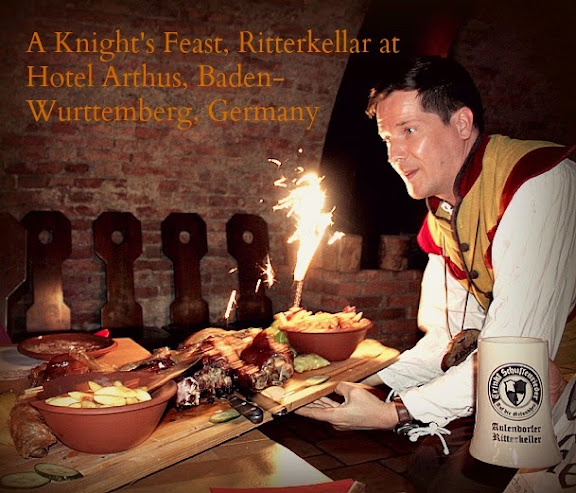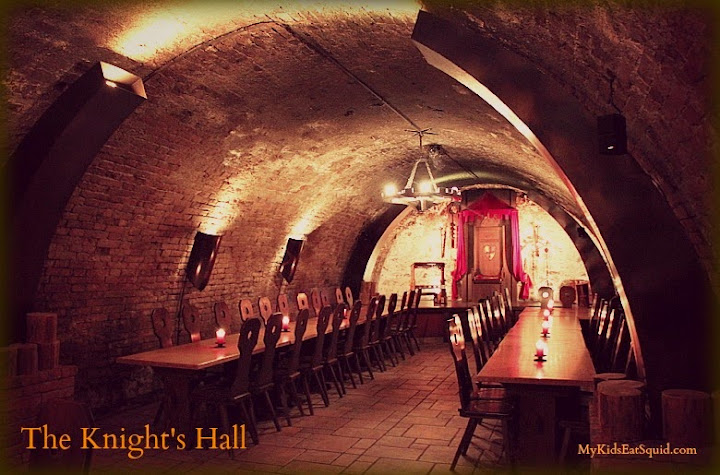Eat Like a Knight at the Ritterkeller
History can be delicious.
To experience another culture, even another time period, it helps to start with your taste buds. That’s what my kids learned on a recent trip through southwestern Germany, which included a stop in the small town of Aulendorf, in Baden-Württemberg.

The town of Aulendorf, near Ravensburg (the namesake of the popular children’s puzzles and toys) is home to the Hotel Arthus, which is designed to look like a medieval castle. The hotel also offers evening feasts where guests can come to eat like a knight for a night.

As you enter the Ritterkeller part of the hotel– loosely translated from German into English as a “knight’s cellar” – a maid greets you and has you wash your hands in a large, wooden bucket of water peppered with rose petals. The dining area has long wooden tables underneath an archway of stone, lit by candles that helps you feel as though you’re entering a knight’s realm.

Our host for the evening on all things knightly was dressed in medieval garb and a sly smile. He explained that it was his job to guide us through how to eat as they would in medieval times. First came fire-baked bread loaves followed by a bowl of soup with a singular, thick noodle that stretched what seemed like a couple of feet once you fished it out of the broth.
In between courses, our host explained various eating customs. For example, royalty, like the king, would have someone else try his food before he ate it to make sure it wasn’t poisoned. Of course, our host asked for a volunteer to do the same. Our food was thankfully poison-free.
Our main course of roasted meats and vegetables arrived on a long board, flanked with a firecracker held in place in a cabbage. The soundtrack from 2001: Space Odyssey, “Also Sprach Zarathustra,” piped through the sound system and the lights were dimmed as the food was being placed on the table, all of which inspired ‘oohs’ and ‘aahs’ from my hungry kids.
In medieval times dining was communal and we did the same. You could grab for the food that you wanted, including chunks of pork, pieces of chicken, vegetables, and noodles. In a nod to the kids, our knightly buffet also included a large bowl of French fries.
The night, which was a mix of history with a heft dose of theatre sprinkled throughout, intrigued my kids. They came away from the experience asking questions about the dining habits of knights. We talked together about how the knight’s might really have feasted in comparison to our evening (we suspect the knights didn’t have fireworks on hand or a soundtrack of songs to match each course of their meal).

Here are a few of the more interesting tidbits we learned about knightly cuisine after doing a little digging after our experience:
· Twice a day meals were the norm. Most likely the knights would have a larger mid-day meal and a lighter, evening meal. Breakfast, apparently, was not considered the most important meal of the day – or even a meal!
· A lifted pinky was useful for seasoning your food. In medieval times, to season food you’d dip it into salt or other seasonings with your pinky before taking a bite.
· In courtly speech (the way the knight’s would have talked to each other), to ask where the bathrooms are you’d most likely say something along the lines of, “Whither be the privies?”
To learn more about the lives of knights, I’d recommend checking out a couple of books with your kids.
Great Medieval Projects: You Can Build Yourself (Build It Yourself) by Kris Bordessa
Knight (Eyewitness Guides) by Christopher Gravett
Kristen J. Gough is the Global Cuisines & Kids Editor for Wandering Educators. She shares her family's adventurous food experiences--and recipes--at MyKidsEatSquid.com.
All photos courtesy and copyright Kristen J. Gough
The town of Aulendorf, near Ravensburg, Germany, is home to the Hotel Arthus, which is designed to look like a medieval castle. The hotel also offers evening feasts where guests can come to eat like a knight for a night.
Posted by:
Kristen J Gough
-

- Log in to post comments


















